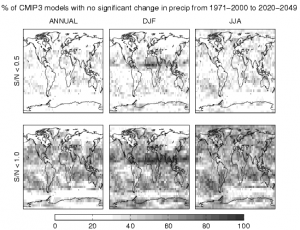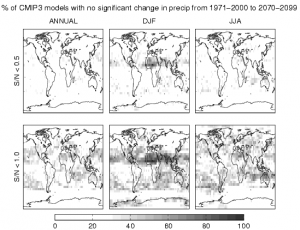In the AR4, the IPCC presented this figure showing the consensus in precipitation projections for the 21st century, designed to be of use to planning for adaptation and mitigation. The coloured regions show where changes are likely to occur. My interest is in the white areas where models cannot agree on the sign of the change. This could mean that half the models predict a large drying and half predict a large increase in rainfall. But, it could also just mean that the changes are small, but that the sign is uncertain.
The figures below show the percentage of GCM consensus that the signal in precipitation change will be smaller than the natural decadal variability in rainfall (S/N < 1) for different seasons and lead times. This could also be of use to planners, indicating that adaptation to natural variability will also adapt to future changes. This helps move from ‘no consensus in a trend’, to ‘consensus in no trend’, which I think was missing from AR4.


Hi Ed,
That’s a really useful point and I agree with you.
I also think that it is not unsurprising that there are regions of significant precipitation change where models don’t agree on the sign because of the physical nature of the changes, namely that wet regions will tend to get wetter and dry regions drier (http://iopscience.iop.org/1748-9326/5/2/025205).
Since the wet and dry regions change from month to month and from model to model the boundary between wet and dry regions is bound to be a region of uncertain precipitation responses. But I completely agree that consensus on the amount of precipitation change, high, low or not much, is important to assess. Is this work being written up?
Nice blog – keep up the good work!
Hi Rich,
Thanks for the comment – I agree that the present day model biases are likely to influence the changes, especially along the boundaries between wet/dry regions.
I am not writing this up at the moment – perhaps I might wait to analyse the CMIP5 simulations – any input gratefully received!
cheers,
Ed.